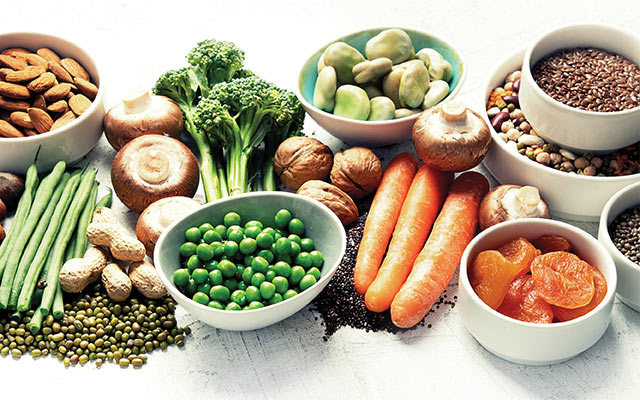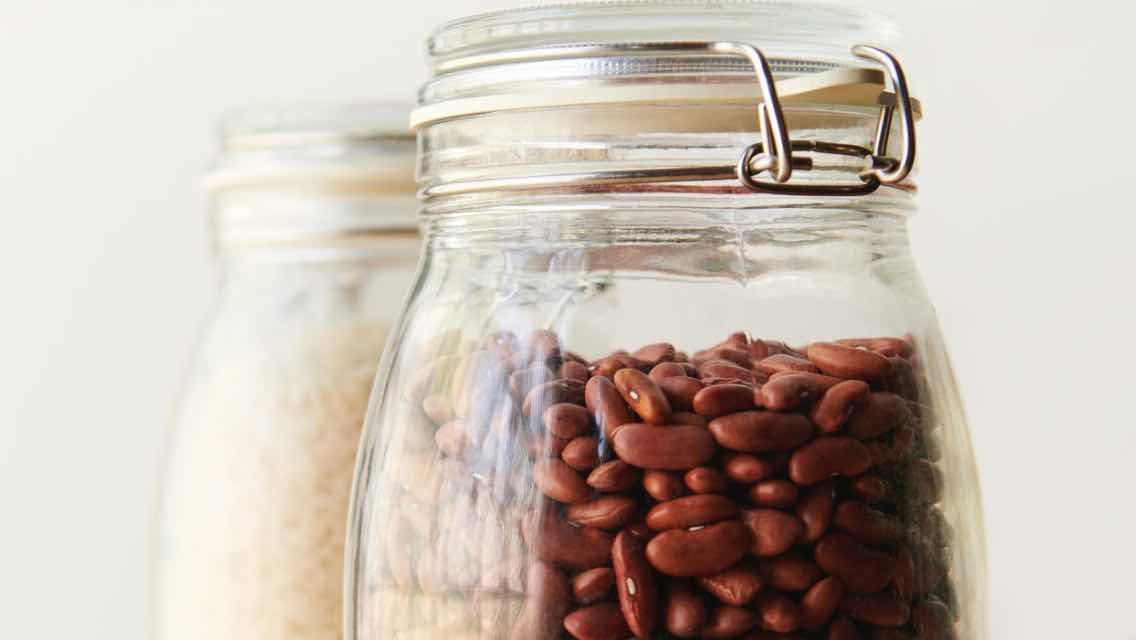Explore this article:
- What Are the Benefits of Fiber?
- How We Became Fiber Poor
- The 3 Types of Fiber
- What are the best whole-food sources of fiber?
- Does eating different kinds of fiber matter?
- Are there times when I will want to moderate fiber consumption?
- What if I just take fiber supplements instead?
- How do I know if I’m getting enough fiber?
When it comes to health, there are flashy topics — and then there’s fiber.
Fiber is best known for its ability to fight constipation, and really, who wants to talk about bowel movements when we could talk about the antitumor potential of turmeric or the body-composition benefits of high-intensity interval training?
Though this overlooked nutrient is critical for maintaining optimal health, most people don’t get nearly enough of it. Not only does fiber-free processed food dominate the standard American diet, many health-conscious eaters are fiber deficient thanks to the popularity of carb-limiting protocols. These diets often skimp on fibrous vegetables in favor of protein and fat.
Even those who embrace healthy whole foods without concern for carbs may not be getting enough fiber.
“The average person only gets half the recommended amount of dietary fiber,” says functional-medicine nutritionist Liz Lipski, PhD, author of Digestive Wellness. And many integrative experts believe the USDA’s current fiber recommendations — 22 grams daily for women and 38 grams for men — are far too low.
“People should be getting closer to 35 to 50 grams of fiber every day,” advises integrative nutritionist Kathie Swift, MS, RDN.
The quest for more dietary fiber isn’t just about preventing constipation, either: It’s a form of preventive medicine.
People who eat fiber-rich diets are at “significantly lower risk for developing coronary heart disease, stroke, hypertension, type 2 diabetes, obesity, and certain gastrointestinal diseases,” according to a meta-review of fiber studies.
Fiber can make you feel full longer, support weight-loss efforts, reduce colon-cancer risk, help prevent and address estrogen dominance, and support mood and cognitive function.
“Fiber is the most underrated nutrient,” says Sarah Ballantyne, PhD, creator of The Paleo Mom blog and author of The Paleo Approach.
Given fiber’s multitude of benefits, it makes sense for all of us to get more of it. Our experts explain how fiber supports health — and how to fit more of it on your plate.
What Are the Benefits of Fiber?
Fiber is most famous for keeping us regular. It does this by adding bulk to stool, which gives the walls of the intestines more to push against to aid peristalsis (the natural wavelike process that moves food along the GI tract). “This is how fiber creates a more regular and more pleasant bowel-movement experience,” explains Ballantyne.
Regular bowel movements mean the body’s waste products are ushered out more quickly rather than hanging around and stirring up a variety of problems. Chronic constipation is associated with vitamin-D deficiency, as well as anxiety, depression, and reduced quality of life — most likely because of the gut–brain connection through the vagal nerve.
Irregular bowel movements have been linked to oxidative stress, which drives inflammation and increases the risk of cardiovascular disease and cancer.
“Our bodies are designed to move waste efficiently,” says Lipski. “We all know what it is like to keep the garbage in the kitchen too long.”
But fiber doesn’t just help speed waste out of the body; it also helps capture it. Fiber has a mesh-like molecular structure, and as it moves through the GI tract, it traps unwanted particles along the way.
“Fiber is able to catch things that cause us harm, like carcinogenic waste, allergens, hormone byproducts, and environmental toxins,” says nutritional biochemist Karen Hurd, MS.
Metabolic byproducts and hormones are the most important substances that fiber cleans up, she adds. Accumulated metabolic-waste products are toxic to cells.
Likewise, if hormones don’t leave the body after completing their initial task, they can cause problems. Once estrogen triggers a menstrual cycle, for example, the liver prepares it for elimination by pairing it with bile, which whisks the used hormone toward the exit.
Many experts, however, see fiber’s most important role as providing food for the gut microbiome, which is key to many diverse aspects of health.
But here’s the hitch: Bile is a fat. Once it reaches the end of the small intestine, where the body absorbs fatty acids, bile will get reabsorbed into the bloodstream unless there’s a “net” of fiber to trap it and take it to its proper destination: the toilet.
“Ninety-five percent of bile is reabsorbed if we are not eating enough fiber,” says Hurd. “And all the hormones in the bile go back into the bloodstream.”
That would be fine if hormones went dormant after performing their initial task, but they don’t. “Hormones are not one-time actors,” she explains. “They just continue to react inside the body after the first wanted reaction. PMS, endometriosis, uterine fibroids — these are all an overexpression of estrogen after it has passed through the GI barrier and come back into the body.”
This pattern isn’t exclusive to estrogen. The same circular process can occur with all our hormones when we’re fiber deficient.
“We think most of our trash is herbicides, pesticides, and bad air,” says Hurd. “But that is the smallest amount of what the liver clears. The vast majority is our own hormones and metabolic waste.”
Fiber makes sure those waste products leave the body for good.
Many experts, however, see fiber’s most important role as providing food for the gut microbiome, which is key to many diverse aspects of health. “Fiber plays a critical role in modulating the intestinal microbiota,” says Swift. “It is the best food for all those microbes that multitask to keep us well.”
Fiber changes the metabolism of gut bacteria, as well as their metabolic byproducts, which can substantially affect our health. For example, gut flora transform fiber into short-chain fatty acids (SCFAs), including a particularly powerful one called butyrate.
The health benefits associated with optimal butyrate levels include protection against insulin resistance, obesity, lung inflammation, asthma, and cancer cells (apoptosis); a lower risk of colorectal cancer and stroke; reduced gut inflammation and oxidative stress; improvements in leaky gut syndrome; and positive impact on gene expression.
Recent research suggests that butyrate may even help us get a good night’s sleep. (Butyrate plays a surprisingly big role in overall health. Learn more at “The Health Benefits of Butyrate.”)
Gut microbes also transform fiber into GABA (gamma-aminobutyric acid), the neurotransmitter that helps regulate anxiety and boosts memory, mood, and cognition. And butyrate and GABA are just two of the important byproducts produced in the gut when we eat fiber.
How We Became Fiber Poor
With so many benefits associated with eating more fiber, you might be wondering how it ever got sidelined.
One explanation may involve its nutritional classification as “nonessential,” which misleadingly implies that fiber is unnecessary. “But we know from past research on the microbiome that [fiber] is the primary food for our gut flora,” says Ballantyne. “It’s now well understood that every chronic illness has a microbiome link.”
Another possibility is that low-carb, high-fat diets have eclipsed high-fiber diets in recent years precisely because they deprive the microbiome of the food it needs to flourish. When the gut’s bad bugs outnumber the good ones — common today, because of a variety of environmental factors — it can trigger a raft of daily complaints. (Think GI issues like gas, bloating, pain, acid reflux, and blood-sugar imbalances, as well as weight-loss resistance or weight gain.)
Removing fiber from the diet, or limiting it in specific ways, starves all the gut bacteria — good and bad — which can dramatically and quickly reduce symptoms. This is a powerful shift for people who have felt crummy for years, so it’s not surprising that many remain on symptom-relieving low-fiber diets indefinitely.
Studies suggest that high-fiber diets help reduce some of the potential risks of high-fat, high-protein diets, like the carcinogens that are produced when meat is charred or the inflammatory compounds that are released as a byproduct of digesting meat or dense protein.
But although it’s healing and helpful to rid the gut of bad bacteria, starving all its microbes is not good for gut health over time.
This is why most experts view low-fiber protocols, like the ketogenic and the low-FODMAP diets, as temporary. Low-fiber diets can effectively rebalance the gut microbial ecosystem and erase symptoms in the short term, but they may pose problems over the long haul.
“The diets we use for dysbiosis starve the microbiota so the microbiome can reset,” says Lipski. “These are therapeutic diets and we don’t have good studies on what happens when someone stays on one of them for a year, two years, or three years. We should think of them as temporary.”
Getting more fiber isn’t an either-or proposition: It’s a both-and. There’s room on your plate for whole-food sources of healthy fat, quality protein from pastured animals, and fiber-rich foods. In fact, fiber may be especially helpful for people who pay attention to carbs or practice high-fat, low-carb protocols.
Studies suggest that high-fiber diets help reduce some of the potential risks of high-fat, high-protein diets, like the carcinogens that are produced when meat is charred or the inflammatory compounds that are released as a byproduct of digesting meat or dense protein.
The 3 Types of Fiber
There are three forms of fiber, and we need some of each to thrive. The different types work together to prevent constipation, promote detoxification, and support a healthy microbiome.
1. Insoluble fiber absorbs fluid and adds bulk in the large intestine. “It makes stools larger and easier to pass,” says nutritional biochemist Karen Hurd, MS.
Sources: Whole grains, nuts, beans, seeds, root vegetables (such as carrots, parsnips, and rutabaga), and fruit with edible seeds, like kiwis, grapes, raspberries, and raisins.
2. Soluble fiber collects bile molecules, metabolic waste products, hormones, and exogenous chemicals so they can be eliminated from the body. When soluble fiber is lacking, waste products get reabsorbed in the intestines and recirculated through the body, which can cause problems. With soluble fiber, these particles “can’t escape the net; they can’t be reabsorbed,” Hurd says.
Sources: Beans, peas, flaxseeds, apples, psyllium, avocados, and Brussels sprouts.
3. Prebiotic fiber feeds the good bacteria in your GI tract to produce health-promoting compounds, like the short-chain fatty acid butyrate.
Sources: Bananas, onion, garlic, dandelion greens, and chicory root.
The Fiber Comeback
Nutrition experts answer some of the most common questions about this nutrient — and explain how to get more of it in your diet.
What are the best whole-food sources of fiber?
When nutritionist Kathie Swift, MS, RDN, asks her students at Kripalu Center for Yoga and Health to list good sources of fiber, most say “bran!” She’s on a mission to change that.
“By the end of class, I want them all to say, ‘vegetables, fruits, legumes, nuts and seeds, and whole grains like quinoa and steel-cut oats.’”
Recognizing a wide array of fiber-containing foods is important for a couple of reasons. One, it highlights the importance of eating diverse sources of fiber. Two, it can help anyone who has food restrictions or who follows low-carb diets get more of it.
“In traditional ketogenic diets, it’s easy to avoid vegetables for fear of going over your carb count for the day,” says functional-medicine practitioner Will Cole, DC, IFMCP, author of Ketotarian. “But there are actually a wide variety of low-carb, nonstarchy vegetable options that are rich in fiber and other nutrients essential for optimal health. These include artichokes, Brussels sprouts, and Swiss chard. Avocados, nuts, and seeds are great sources of fiber and healthy fats.”
Soluble-Fiber Sources
Soluble fiber is the sticky web that catches waste products. Here are some great whole-food sources.
- Legumes: These may be nature’s richest source: 1 cup of beans contains about 5 to 8 grams of soluble fiber. Hurd recommends adults get at least 5 grams of soluble fiber every day.
- Vegetables: One avocado, 1 cup of Brussels sprouts, and 1 cup of sweet potatoes each contain roughly 4 grams of soluble fiber.
- Fruits: Some health-conscious eaters eschew fruit because of concerns over blood sugar, but experts counter that its fiber helps regulate any spikes. “The idea that fruit is bad for you is ridiculous,” says Swift. Dried figs have just under 8 grams of fiber in a cup. One medium-size orange has around 1.8 grams, and one medium-size pear with the skin on has between 1 and 1.5 grams.
Does eating different kinds of fiber matter?
Microbial diversity is a hallmark of a healthy gut microbiome, and one of the biggest factors is consuming fiber from diverse sources.
“Diversity of fiber is the most important determinant of what will grow in the gut,” says Sarah Ballantyne, PhD. “Think of the gut microbiome like a bustling city — a city that works because people have different jobs. Some are teachers, some are doctors, some are trash collectors.”
Each of these microbes prefers a specific kind of fiber, and you can’t afford to starve any one class of worker. The greater variety of types of fiber in your gut, the better fed the workers in your bustling city will be.
“You need all those jobs to be filled,” Ballantyne adds, “so you don’t have class sizes that are too big for one teacher, or trash piling up in the alleyway, or too long a wait for the doctor.”
Are there times when I will want to moderate fiber consumption?
Fiber is food for gut bugs. This is great news if the good and bad bacteria in the gut are in balance. But if the bad outnumber the good — a condition called gut dysbiosis, which can cause gas, bloating, pain, and reflux — temporarily cutting out fiber can help starve them out, curtail symptoms, and reset the gut’s microbial ecosystem.
The key word here is “temporarily.” Most low-fiber protocols are short-term therapeutic approaches overseen by a healthcare practitioner. If you suffer from dysbiosis and want to try a low-fiber protocol, like the low-FODMAP or keto diet, work with a professional to get started. (For more on FODMAPs and ketogenics, see “Can An Elimination or Low-FODMAP Diet Treat IBS?” and “What You Need to Know About the Keto Diet”, respectively.)
Likewise, anyone with an inflammatory intestinal disease will want to avoid a lot of fiber during a flare-up, advises Swift, “just to get the gut to calm down.” This includes conditions such as ulcerative colitis or diverticulitis (when small pouches that form in the intestines become inflamed or infected). But that avoidance, too, is best considered temporary; once the flare-up eases, consuming adequate dietary fiber may help prevent another episode.
What if I just take fiber supplements instead?
Supplements won’t hurt you, but their benefits are limited because they usually contain only one source of fiber — such as psyllium or guar gum. And though supplements often deliver about the same amount of fiber as a serving of high-fiber food, whole foods are generally preferable because they contain diverse forms of fiber, as well as health-promoting phytonutrients and other healing compounds.
“My favorite fiber supplement is food, because you get a variety of soluble and insoluble fibers — and these insoluble fibers, or prebiotics, are food for the gut,” says nutritionist Liz Lipski, PhD, who adds that supplements are helpful when traveling and you’re unable to cook. Just don’t make them your main source.
How do I know if I’m getting enough fiber?
The real test is in how often you poop — or don’t. “We should be having one to three bowel movements every day,” says Lipski. “So many people are having bowel movements every other day, and that’s not enough.”
Another measure of fiber intake is ease of elimination. “When you get enough fiber, you will have bowel movements that look like brown bananas and they just flow out of you,” adds Lipski. “If you like to read while you have a bowel movement, you will be disappointed when you eat enough fiber and are well hydrated, because you don’t need much time in the bathroom.”
This originally appeared as “The Facts on Fiber” in the September 2020 print issue of Experience Life.




This Post Has One Comment
Very informative….